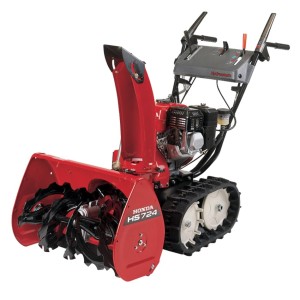 When the last of the snow melts and frequent snowblowing is replaced by concerns about getting the lawn in top shape for the coming summer season, it’s time to consider the best practices for snowblower storage. The good news is that this process, though essential, is actually quite easy. Quick fluid checks, maintenance routines and lubrication, will ensure that the snowblower stands up to storage easily, and is ready to go at a moment’s notice when winter weather makes its inevitable return.
When the last of the snow melts and frequent snowblowing is replaced by concerns about getting the lawn in top shape for the coming summer season, it’s time to consider the best practices for snowblower storage. The good news is that this process, though essential, is actually quite easy. Quick fluid checks, maintenance routines and lubrication, will ensure that the snowblower stands up to storage easily, and is ready to go at a moment’s notice when winter weather makes its inevitable return.
Safety Check: Don’t Proceed Without Ensuring an Injury-Free Experience
Safety is tantamount during snowblower maintenance and storage preparation. To minimize the risk of cuts, burns and other hazards, be sure to allow the engine to cool if the snowblower was recently turned on for any reason. Perform maintenance on a solid, level surface, and make sure that the area is either well ventilated or outdoors. Keep bystanders and pets out of the area during maintenance, and make sure that any work with the engine or auger is done only when protective gloves and goggles are being worn. With those considerations made, it’s time to get down to business.
Storage Preparation: What to Know Before Final Storage
There are a few key things to understand about snowblower maintenance, each of which will ensure that fuel is fresh, oil is sufficient, and other parts of the equipment are sufficiently clean and lubricated so that they don’t suffer from damage during the summer.
1. Equipment Cleaning
Snowblowers might deal primarily in clearing away frozen water, but they still have a knack for getting pretty dirty in the process. Over time, that dirt can cause real problems for engine performance, auger longevity, and other key aspects of operation. Before storing the snowblower, be sure to mix a bit of dish detergent with warm water, and give the snowblower a thorough cleaning. Make sure that both the snowblower’s exterior surface and its interior areas, like the auger housing, and cleaned during this process.
When the snowblower has been sufficiently cleaned inside and out, use a towel to drive off any excess water. This will ensure that the snowblower doesn’t inadvertently begin to rust as it dries and sits in storage for an extended period of time during the summer season.
2. Fuel Concerns
There are generally two ways to approach the remaining fuel that might be left in the snowblower after the last snowstorm and before summertime storage. Some operators, and perhaps the majority of them, prefer to drain the fuel since it will easily become stale over the course of the summer. When the weather cools down again, that fuel will need to be drained anyway. Ridding it from the fuel tank ahead of time just makes it easier to prepare the equipment for use next time.
Increasingly, however, many equipment owners prefer to leave remaining fuel in the tank and add a sufficient amount of stabilizer so that it effectively remains “fresh” for many months at a time. This has also been said to reduce the likelihood of corrosion in or around the fuel tank during storage. Whichever method is chosen, be sure to follow the exact, step-by-step process in the snowblower’s user manual.
3. Engine Oil
Prior to storage, old oil should be drained and new oil should be added until it reaches the recommended fill line on the dipstick. As with virtually all snowblowers, Honda recommends that today’s equipment owners use a 5W30 during every oil change. This oil is simply the best choice for very cold temperatures, which is the environment in which it will be used next season as the first flakes fly. Remember to dispose of all old oil in a safe, environmentally friendly way.
4. Tire Check
The tires on a snowblower are exposed to all kinds of abuse during the winter season. They routinely roll over sharp and icy edges, deep and abrasive snow, and handle all kinds of cold weather that can cause rubber to rack quite easily. Before storing the snowblower, check the tires to ensure that they’re free of major damage or wear. If they’re cracked or showing signs of significant wear, seek OEM Honda replacement tires that will get the job done more capably next year. If the tires have low air pressure, be sure to fill them appropriately.
Visit HondaLawnParts.com for Storage Maintenance Parts and More
Getting ready for springtime is as much about preparing landscaping equipment as it is preparing winter’s equipment for long-term storage. More often that not, operators will need at least one replacement part to keep their snowblower in great shape throughout the summer months. HondaLawnParts.com makes it easy to find the right parts for the HS724 snowblower and every other Honda model. An online parts lookup tool can narrow down available replacements by model number, engine manufacturer, and part number, taking the guesswork out of seasonal storage preparation.
